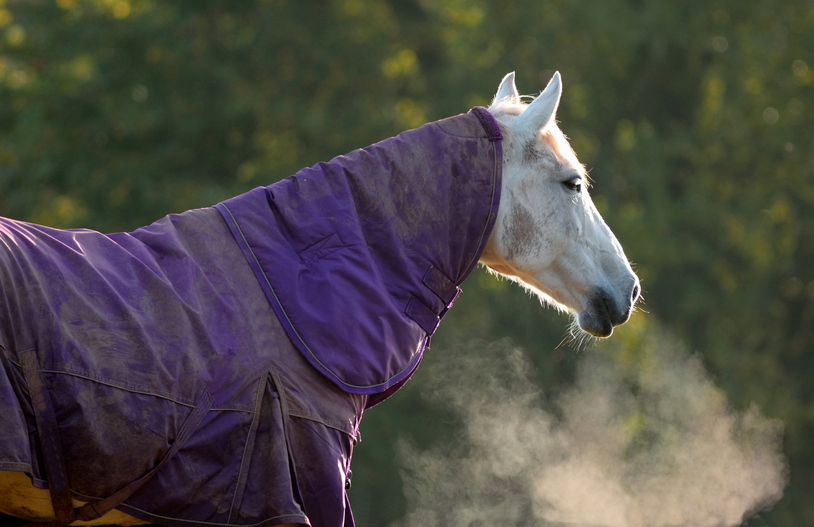Everybody’s talking about rugs...
At this time of year the hot topic of discussion tends to be whether or not to rug and if rugging what weight of rug to use. There are lots of opinions out there from proponents of the “naturally” kept horse to welfare charities, vets, professional riders and livery yard owners, but can science offer us any guidance?
Firstly, what we do know is that horses are able to adapt to a wide range of environmental conditions and can happily live in climates where temperatures fall as low as -40°c. Because of their size, horses have a small surface area to body weight ratio meaning they retain heat easily which is an advantage in cold climates. In contrast humans, being smaller, have a greater ratio of surface area to body weight meaning we lose heat more easily than the horse. This explains why there is sometimes a disconnect between how cold we think it is and how cold the horse actually is.

However, in terms of actual scientific research there has been done to investigate rugging choices by horse owners and the effect those choices have on the comfort of the horse. Interestingly one 2019 research project decided to “ask” a group of 23 horses (10 who usually wore rugs and 13 who didn’t) what they preferred based on the current weather conditions. The horses were trained to choose between 3 symbols representing:
-
Rug On
-
Rug Off
-
No Change
It took 2 weeks for the scientists to feel confident that the horses understood this method of communication and were able to consistently state their preferences. The results showed that the horses had a clear preference for wearing a rug when temperatures were low, in this case below minus 10°c (-10°c) whilst when air temperatures were above 10°c (+10°c) very few of the horses chose to wear a rug. However, as you’d expect, even when temperatures were moderate (5-10°c) but it was wet and windy the horses showed a clear preference for having a rug on.
You might also expect a similar result when it was snowing but the researchers actually found that only 59% of the horses wished to wear a rug in these conditions. They speculated this was likely because the group of horses were well adapted to living in cold weather being from Norway and Sweden and that the snow tended to sit on the top of their coats rather than penetrating the insulating layer of hair.

So, does that help us here in the UK make informed choices about when to rug and what weight of rug to use? I’m not sure. The results of the study weren’t particularly surprising although I’d love to be able to train my horse to tell me what they preferred – or perhaps not! I’m also not sure if the decision is more about what weight of rug to use rather than whether or not to rug. We all know that overweight horses are a major welfare concern and research has shown that leisure horses are more likely to be overweight than performance horses. We also know that under rugging (i.e. putting on a lighter rug than we might otherwise do) is a useful way to help horses lose weight as they move more and use up fat reserves to keep warm.
I have 2 horses to make rugging decisions about this winter. My youngster has insulin dysregulation meaning he’s the proverbial “good-doer” prone not only to putting on weight but also to laying down adipose fat, in other words fat pads. The winter is a great time to get off any weight he has put on during the autumn flush of grass so I will tend to go for a lower weight rug than I might put on my older horse and rarely does he have more than a light weight (100gram) on throughout the whole winter. However, if it is wet, windy and cold he will definitely get a neck cover and in exceptionally cold weather a medium weight rug. The older horse however has a tendency to lose weight easily, moves about less and hates the cold, wet weather (despite living in Scotland for many years) so he will get a heavier weight rug.

As a general rule as the winter progresses if the weather is cold but bright and sunny I won’t rug. If it looks like raining but is relatively mild and I want to ride later in the day then I tend to use a no fill turnout rug just to keep them clean. The other thing I am quite religious about is taking regular weigh tape measurements. Our eye can be quite deceiving and sometimes I’ll look at the youngster and think he’s put on weight when actually there’s been no change since the previous month. Other times he looks like he’s dropped weight but the weigh tape disagrees. And whilst I accept that weigh tapes are not particularly accurate they are a good way of objectively identifying any change.
My best advice when making your own rugging decisions is that you know your horse best. If they need a rug on then put a rug on. If not, then don’t. Please don’t be persuaded to do something you know is not right for your horse just because everyone else on the yard or on social media is doing it. But also bear in mind that temperatures do rise during the day so when you turn out before work it may be a little fresh but is likely to change by the afternoon particularly at this time of year. And if you want to put a rug on to keep your horse clean enough to ride later that’s OK too.
I’ve included the references to the studies below just in case you want more detail or are perhaps looking to train your own horses to give their preferences!



